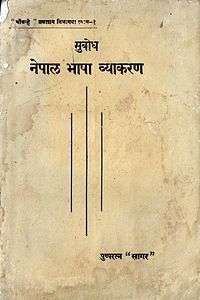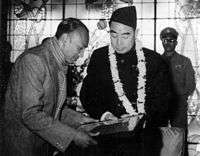Pushpa Ratna Sagar
Pushpa Ratna Sagar (Devanagari: पुष्प रत्न सागर) (born Pushpa Ratna Tuladhar) (29 October 1922 – 11 November 2011) was a Nepalese merchant, grammarian, lexicographer and pioneer pressman.[1] Born Pushpa Ratna Tuladhar in Asan Dhalasikwa, Kathmandu, he acquired the nickname Sagar in his childhood during a pilgrimage to Ganga Sagar (Sagar Island) in India. He was the third and youngest son of trader Pushpa Sundar Tuladhar and his wife Dhan Maya.



Early life
Sagar received primary education at a neighbourhood school conducted at the home of teacher Jagat Lal Master. He was married to Lani Devi Bania of Itum Bahal on 12 January 1942. In 1943, he left for Lhasa, Tibet[2] to join his ancestral business house Ghorasyar.[3]
Career
While in Lhasa, he was stirred by the activism in Nepal against the suppression of Nepal Bhasa and imprisonment of writers by the Rana regime.[4] He thought of doing something for his mother tongue, and started writing a grammar of the language that would be useful to students. In 1949, he returned to Kathmandu where he completed the manuscript. The grammar, entitled Subodh Nepal Bhasa Vyakaran, was published in 1952.
In 1951, Thaunkanhe, the first Nepal Bhasa monthly magazine to be published from Nepal, began publication with Sagar as the deputy editor.[5] In a bid to promote publishing in Nepal Bhasa, Sagar formed a partnership with two like-minded former Tibetan traders, Purna Kaji Tamrakar and Ratna Man Singh Tuladhar, and in 1952 established Nepal Press at his home at 11/122 Asan Tyouda Tol, Kathmandu. Their equipment consisted of second-hand Vicobold letterpress machines imported from Kolkata.
Sagar was also active in a number of associations. He was a member of Dharmodaya Sabha (Society for the Rise of the Teaching), a Buddhist organization founded in 1944 in Sarnath, India by exiled Nepalese monks and dedicated to promoting Theravada Buddhism.[6]
In 1957, he was secretary of the Kathmandu chapter of the Nepalese Chamber of Commerce, Lhasa when it hosted a reception to honour visiting Chinese Premier Zhou Enlai.
In 1960, Sagar set up Nepal Printing Press and continued his service to Nepal Bhasa. He compiled a dictionary of original words with meanings in Nepal Bhasa, Nepali and English, and in 1998, published it under the title Nepal Bhasaya Maulik Sabdakosh.[7]
Honors
On 31 October 1994, Nepal Bhasa Parishad decorated Sagar with the title Bhasa Thuwa (Patron of the Language).[8]
He was made a patron of Nepal Lipi Guthi, an organization dedicated to preserving Nepalese scripts.[9]
In 2008, chairman of the Constituent Assembly Subash Nemwang presented Sagar with a letter of felicitation to honour his contribution to Buddhism in Nepal at a function organised by Dharmodaya Sabha.[10]
Published works
- Subodh Nepal Bhasa Vyakaran (Understandable Nepal Bhasa Grammar), 1952
- Nepal Bhasaya Maulik Sabdakosh (Original Dictionary of Nepal Bhasa), 1998
See also
- Lhasa Newar (trans-Himalayan traders)
References
- "Pioneer pressman passes away". The Rising Nepal. 14 November 2011. Page 3.
- Tuladhar, Kamal Ratna (22 March 2009). "A man of letters". The Kathmandu Post. Retrieved 8 December 2011.
- Tamrakar, Purna Kaji (2004). "My Incomparable Friend: Kesar Lall Shrestha". Retrieved 12 December 2011. Page 81.
- Hutt, Michael (December 1986). "Diversity and Change in the Languages" (PDF). CNAS Journal. Tribhuvan University. Retrieved 9 December 2011. Page 10.
- Tamrakar, Purna Kaji (2004). "My Incomparable Friend: Kesar Lall Shrestha". Retrieved 12 December 2011. Page 81.
- Sthavir, Dharmalok (1 December 1977). "A Journey to Great China". Regmi Research Series. Regmi Research. Retrieved 9 December 2011.
- Nepalabhāshāyā maulika śabdakośa (Thaukanhe Prakāśana Vibhāga, 1998)
- "Nepal Bhasa Puraskar". Kantipur. 1 November 1994. Page 1.
- "Patrons of the Guthi". Nepal Lipi Guthi. Archived from the original on 14 October 2011. Retrieved 11 December 2011.
- "Recent News". The Rising Nepal. 2008. Archived from the original on 7 April 2012. Retrieved 8 December 2011.